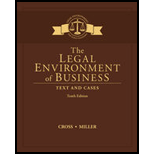
Case summary:The Environmental Protection Agency (EPA) developed two rules namely, Phase I and Phase II. Phase I rule provides for the restriction of water inflow to a level equivalent to a level achieved through a closed-cycle recirculating cooling system. Phase II rule applies "national performance standards" to over 500 existing plants. They pleaded that converting these plants to closed-cycle systems will bear more costs and fewer benefits. Various environment organizations were aggrieved by this decision and they challenged phase II rule in US court.
To find: Necessity to draw a line on the nation’s border while analyzing the actions affecting the environment.
Want to see the full answer?
Check out a sample textbook solution
Chapter 25 Solutions
Lms Integrated Mindtap Business Law, 1 Term (6 Months) Printed Access Card Cross/miller’s The Legal Environment Of Business: Text And Cases, 10th
- Imagine you have the sole marketing rights to a new herbal shampoo that you developed from local herbs and plants that are indigenous to your country. This shampoo can stop hair loss and promote hair growth for those who have suffered hair loss. You have branded it Nasure® Shampoo, and given your limited capital, you plan to sell your product exclusively over the Internet and support it by advertising and infomercials on late-night television. You have also planned some social media marketing, plus you are also hoping to obtain free publicity in men's fashion magazines. You plan to sell the product in a 400-gram bottle for $599 plus $9.99 shipping and handling. This price is considered premium to that of competing products, but you justify this based on the unique properties of the shampoo Using the information provided, identify each element of your marketing mix. (NB, you are NOT required to define marketing mix, but to list the marketing mix elements of the company). Identity the…arrow_forwardA bond with a par value of $1,000 and a maturity of 8 years is selling for $925. If the annual coupon rate is 7%, what’s the yield on the bond? What would be the yield if the bond had semiannual payments?arrow_forwardWhat are the budgeted cash receipts from sales on account for July on these financial accounting question?arrow_forward
- financial accountingarrow_forwardYou want to buy equipment that is available from 2 companies. The price of the equipment is the same for both companies. Silver Fashion would let you make quarterly payments of $14,930 for 8 years at an interest rate of 1.88 percent per quarter. Your first payment to Silver Fashion would be today. Valley Fashion would let you make X monthly payments of $73,323 at an interest rate of 0.70 percent per month. Your first payment to Valley Fashion would be in 1 month. What is X?arrow_forwardPlease need answer the general accounting questionarrow_forward
 Foundations of Business (MindTap Course List)MarketingISBN:9781337386920Author:William M. Pride, Robert J. Hughes, Jack R. KapoorPublisher:Cengage Learning
Foundations of Business (MindTap Course List)MarketingISBN:9781337386920Author:William M. Pride, Robert J. Hughes, Jack R. KapoorPublisher:Cengage Learning Foundations of Business - Standalone book (MindTa...MarketingISBN:9781285193946Author:William M. Pride, Robert J. Hughes, Jack R. KapoorPublisher:Cengage Learning
Foundations of Business - Standalone book (MindTa...MarketingISBN:9781285193946Author:William M. Pride, Robert J. Hughes, Jack R. KapoorPublisher:Cengage Learning


